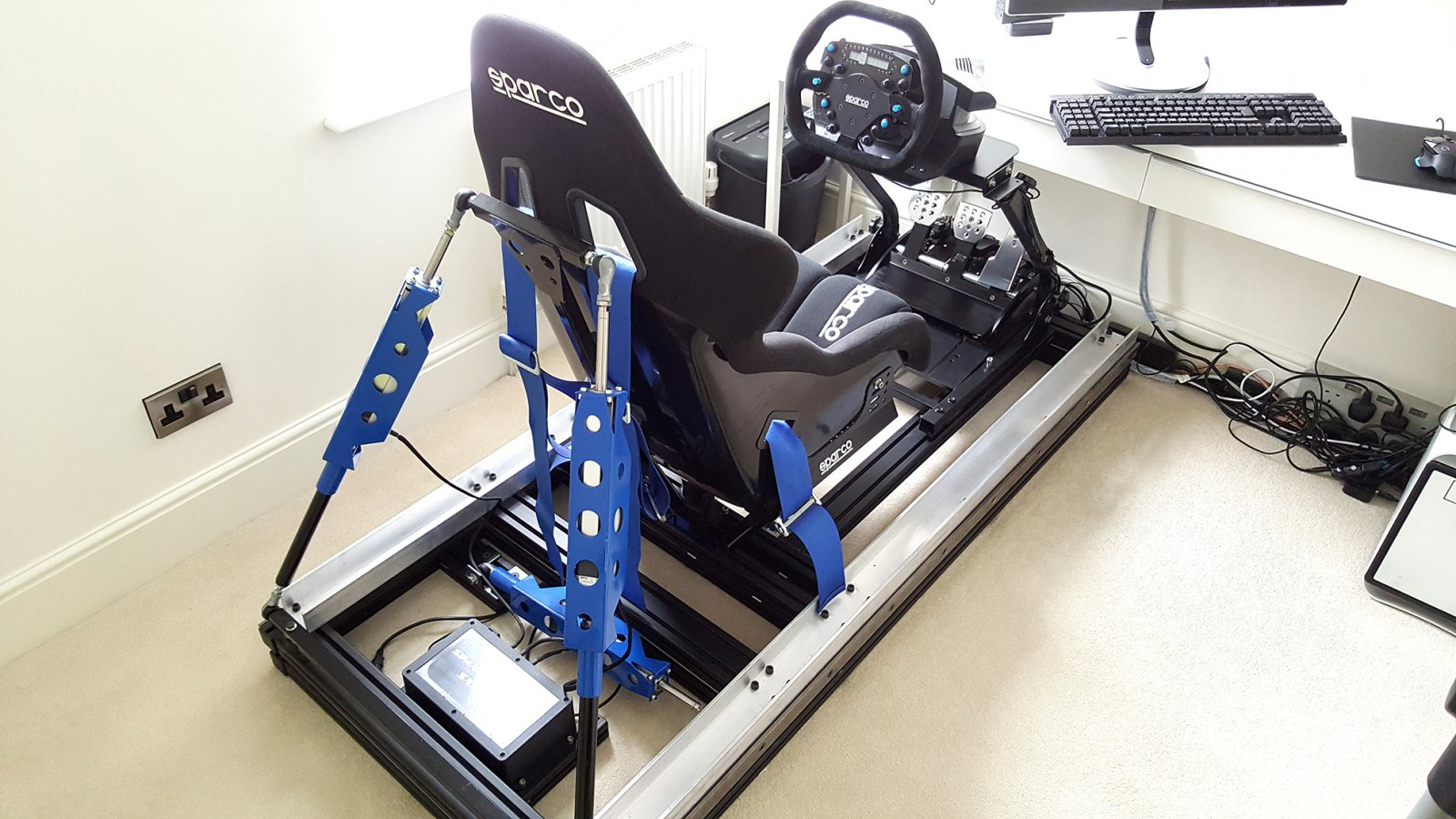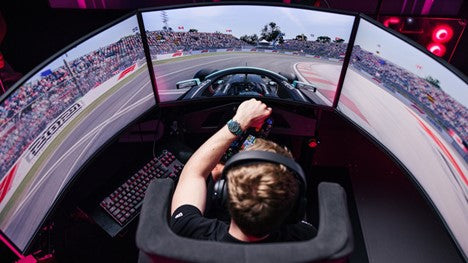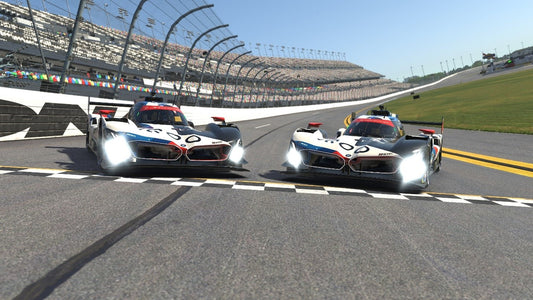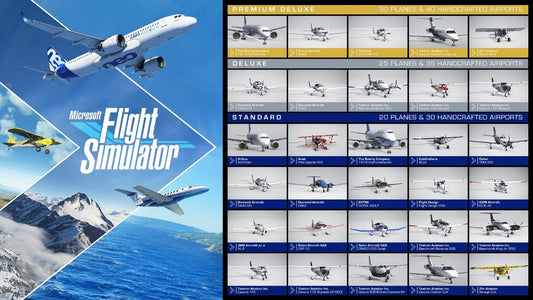How the 'Motion' Simulator Technology Works in a Racing/Flight Simulator!

Figure 1: A Motion Equipped Race Simulator
Ever wondered how the motion simulator technology translates in-game action into real-world movement as experienced on your sim setup? What actually goes on under the hood of a motion simulator?
Back when I was a teen gamer, I spent countless hours marvelling at how the motion platform was able to make sense of what was currently going on in the game and hence respond with such precise, lifelike motion. As it turns out, much of this is rooted in the basic firmware of the sim hardware components as well as the coding that goes into making simulator games themselves.
While we won’t be delving into the technical nitty-gritty here, it’s worthwhile to understand the core principles of how motion platforms bring sim games to life. From DOFs and motion cueing to the role of actuators and motors; let's break down the basics of how these systems work together to make your simulator respond as though you’re actually on the track or in the air!
Racing Simulator Motion System
The racing simulator motion system is designed to replicate the physical dynamics, like acceleration, braking, and cornering forces; of a real car. These are achieved by using a motion platform which is driven by the combination of hardware actuators, software integration, and motion cueing techniques that work together to simulate the physical sensations of driving.Motion Platform

Figure 2: Racing Simulator With Motion Rig
Usually, the first thing you notice about a racing motion rig is its platform that lies underneath the seat. This is a rectangular or square shaped structure that receives input signals from simulation software/games like iRacing and Assetto Corsa Competizione, and moves accordingly to accurately mimic a car’s virtual movement in-game.
There are different types of motion platforms, each varying in complexity depending on their Degrees of Freedom (DoF):
- 2 Degrees of Freedom (DoF): 2 DoF motion rigs let you tilt the seat forward/backward (pitch) and left/right (roll), giving you the sensation of acceleration, braking, and cornering forces.
- 3 Degrees of Freedom (DoF): Same as 2 DoF but adds yaw, which rotates the seat to simulate turning motions.
- 6 Degrees of Freedom (DoF): Typically found on higher-end motion rigs that are capable of simulating nearly every aspect of a car’s movement, including bumps, crashes, and off-road vibrations. Unlike 2 DoF and 3 DoF, 6 DoF motion rigs support full motion: pitch, roll, yaw, surge, sway, and heave.
The constant motion changes feed your inner ear with sensations that mimic real-world driving dynamics, allowing for a highly immersive experience even though the actual G-forces are not being produced.
Actuators

Figure 3: Simulator Actuators
The motion platform movement is caused by none other than the actuators. These are small electromechanical devices fitted inside the motion rig that receive electrical signals from the control system. Actuators are perfectly in sync with a game’s physics engine and their job is to translate these electrical signals by a motion control system into physical movement to give rise to corresponding in-game motion, such as speed, turning angles, and impact forces.
Generally, there are two types of actuators found in motion rigs: Linear and Rotary. Linear actuators move the platform up and down or forward and backwards. Rotary actuators, on the other hand, provide tilting and rotational motion for roll, pitch, and yaw. It is the number and placement of these actuators that actually determine the Degrees of Freedom (DoF) the motion platform can achieve.
At the heart of a racing simulator motion system lies a motion control system. You can think of it as an intermediary between the physical motion rig and simulator software/games like rFactor 2 and F1 2024. This control unit works by continuously monitoring real-time vehicle telemetry from the game and sends relevant commands to the actuators as needed.
Motion Cueing

Figure 4: A Person Racing on A Motion Equipped Race Simulator
One of the most fascinating techniques in motion simulator technology is motion cueing. It is a method that tricks the brain into perceiving sustained forces without requiring large physical movements. Since hardware simulators cannot replicate the full range of movements, like long accelerations or cornering forces, motion cueing creates a convincing experience within limited space. This effect is achieved by two main methods: “Tilt Coordination” and “Scaling and Filtering.”
In tilt coordination, the platform itself tilts to simulate acceleration or deceleration instead of physically moving long distances. This technique tricks the brain into perceiving G-forces even though the rig doesn't move as much as the actual vehicle would.
In scaling and filtering, motion cueing software scales and filters out certain movements that wouldn’t feel realistic in a small space while emphasising movements like vibrations and smaller tilts that make the experience feel more real on a racing simulator motion system.
Flight Simulator Motion System
Just like with a racing motion rig, the "motion" in a flight simulator is designed to replicate the physical sensations of flight, such as acceleration, turbulence, and manoeuvring; to give the pilot a realistic flying experience. This is achieved by using a motion platform driven by precise actuators, sophisticated software, and motion cueing that work together to trick the brain into experiencing a convincing real flight.Motion Platform

Figure 5: A Flight Simulator With Motion Rig
A flight simulator motion system is produced by a motion platform, often referred to as a 6-DOF (six degrees of freedom) platform. This platform is typically a hexapod or Stewart platform, containing six independent actuators that allow it to move in six different axes comprising translational and rotational movements.
These six degrees of freedom allow the motion platform to mimic the various forces a pilot would experience in real life, including:
- Pitch: Forward or backward tilt to simulate nose-up or nose-down attitudes.
- Roll: Tilting side to side to simulate banking turns.
- Yaw: Rotation around the vertical axis to simulate the aircraft's directional movement.
- Heave: Vertical movement to simulate altitude changes or turbulence.
- Sway: Lateral movement to simulate side-to-side forces (like a crosswind).
- Surge: Forward and backward movement to simulate acceleration and deceleration.
One of the main limitations of flight simulator motion systems is that they cannot simulate prolonged G-forces as experienced during sustained climbs, dives, or tight turns. Regardless, there are certain techniques which help to mitigate this: Platform Tilting and Short Motion Bursts.
- Platform Tilting: In this technique, the motion platform tilts to mimic the sensation of pressure against the body (e.g., backward tilt simulates forward acceleration). This fools the inner ear into feeling the force, even though the platform isn't actually accelerating at the same speed as a real aircraft.
- Short Motion Bursts: Here, the flight simulator uses short, intense movements to simulate rapid changes in acceleration or deceleration which creates a sensation that mimics real-world forces without sustaining the motion over time.
Actuators

Figure 6: Simulator Actuators
Actuators are electromechanical devices responsible for translating electrical signals into physical movements. They move the motion platform as or when directed by a flight sim software/game like Microsoft Flight Simulator 2024 or X-Plane 12. While the exact protocols of communication between sim software/games and sim flight components are handled by a dedicated motion control system, these are actuator motors that bring motion to life.
A flight motion rig typically relies on electric or hydraulic actuators. While pneumatic actuators are also found, they are generally limited to the lower end of sim flight setups.
- Hydraulic Actuators: These are used in larger, more powerful simulators as they provide high levels of force and are capable of generating fast and smooth motion.
- Electric Actuators: These are more common in mid-range flight simulator setups. The only advantage of having electric actuators is that they are quieter and require less maintenance than hydraulic systems.
Motion Cueing

Figure 7: Industry Level Simulator Actuators
Where real flight involves sustained accelerations over long distances, a simulator is confined to the space available by the motion platform. It is one of the key challenges of a flight simulator motion system since accurately imitating the sensation of movement in a limited physical space is important.
For those unaware, motion cueing is the process of creating the illusion of sustained motion using limited movement. In modern sim flight setups, this is done by meticulously combining linear accelerations and washout algorithms.
In linear acceleration, the flight simulator platform quickly tilts in the direction of acceleration (e.g., pitching upward during take-off). This tilt is sensed by the pilot’s inner ear and body as forward acceleration, mimicking the sensation of speed changes.
After simulating a motion (e.g., a sharp turn or climb), the motion system has to "wash out" the motion by returning the platform to a neutral position in a way that is subtle and doesn’t disturb the pilot’s sense of immersion. This is where Washout algorithms come into play to ensure smooth transitions back to a neutral state without the pilot feeling the simulator resetting itself.
Conclusion

Figure 8: A Hybrid Race and Flight Simulator
Motion simulator technology makes it possible to experience real-life racing and flying simulations right at home. While there are certain limitations to it, continuous advancement in technology is ever closing the gap. It’s only a matter of time until the lines between reality and simulation are removed, allowing you to wholly immersive yourself into hyper-realistic simulations, whether be it race or flight!





